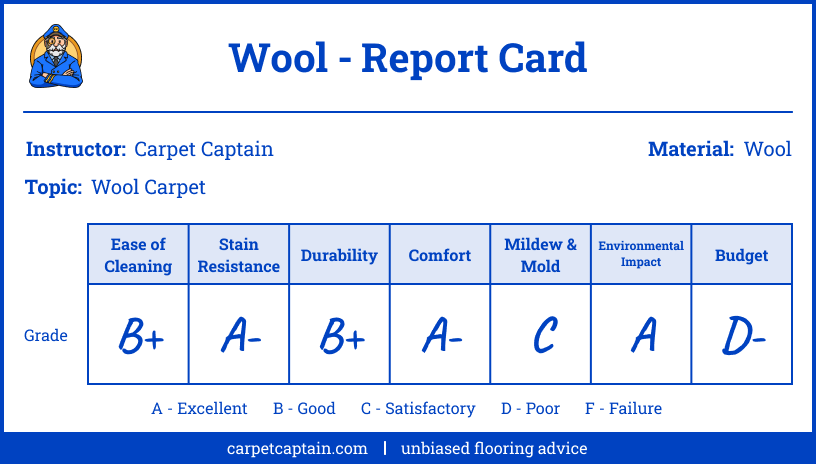Wool Carpet Pros and Cons + Actual Owner Experiences From My Readers
“We are finally replacing wool carpeting installed in 1941.” This is a snippet from an email I received on March 29, 2012. That means she had her wool carpet for 71 years! That’s in my record book of longest I’ve heard of a carpet lasting. On the other end of the spectrum, I received an email from a person who’s wool carpet looked damaged in one year! So how did the same wool carpet fiber perform so differently? I can’t say for sure, but I have a few ideas. It comes down to the advantages and disadvantages. Wool does great in some situations and can be vulnerable in others. Let’s dive into the wool carpet pros and cons and you’ll know if it’s right for you:
 Captain’s warning! Be on the lookout for wool blends. Some carpets will say wool in the name but have other materials mixed in. This will be disclosed on the carpet information under ‘material.’ Also, you can check out my article on blended carpet materials if you’re considering one of these carpets.
Captain’s warning! Be on the lookout for wool blends. Some carpets will say wool in the name but have other materials mixed in. This will be disclosed on the carpet information under ‘material.’ Also, you can check out my article on blended carpet materials if you’re considering one of these carpets.Pros of wool carpet
Wool is the only carpet material I would classify as a luxury. Brands like Masland built on this. Let’s look at some of its advantages:Resilient
Have you ever seen a sheep with a bad hair day? I haven’t (although to be fair, I haven’t been around too many sheep). Wool is highly resilient, meaning it keeps its shape. Most carpets wear down and matt down over time. This can be one of the first things that makes a carpet look like it needs to be replaced. This may be the secret reason that my reader’s carpet was able to last over 7 decades.Stain resistance
Wool carpet’s ability to resist stains goes a step beyond other fibers. When properly treated, all fibers have a degree of stain resistance. Wool fiber naturally does a good job of repelling stains (treated nylon and Smartstrand carpets probably resist liquid stains better). In addition, wool does a good job of hiding soil stains and repelling oil stains, whereas the other fibers tend to attract oils. Oils are commonly tracked in from asphalt, garages, cooking agents (some even become airborne with heat or spray bottles), and they are even on our skin. Wool repels these oils, helping it maintain its clean appearance. Captain’s warning!Wool’s natural stain resistance is excellent against oils. However, it’s not so excellent against spills. Just like wool carpet can be dyed to give it color (think of a wool rug), spilled juice can also dye it. If you want to protect against these kinds of stains, make sure your wool carpet comes with stain protection applied at the factory.
Captain’s warning!Wool’s natural stain resistance is excellent against oils. However, it’s not so excellent against spills. Just like wool carpet can be dyed to give it color (think of a wool rug), spilled juice can also dye it. If you want to protect against these kinds of stains, make sure your wool carpet comes with stain protection applied at the factory.Unique comfort
Wool and polyester carpet are the go-to carpets when comfort is the highest priority. Wool is unique because it combines softness with springiness. Where many soft carpets crush easily, wool carpet maintains its comfort for years.Hypoallergenic/Organic
Wool carpet comes off the sheep’s back and can be manufactured without any dyes or synthetic chemicals. This makes it hypoallergenic (for those not allergic to wool) and great for parents who are concerned about exposing their kids to chemicals.Insulation
The one-way wool carpet might justify its cost is by reducing your heating and air conditioning bills. Wool is a great insulator, so it will limit the transfer of heat (or cool air) from the outside world into your home.Fire resistant
Wool doesn’t melt. It has natural fire resistance. While this is a cool benefit, its practicality may be of little benefit. One “benefit” is it will not melt if you drop a cigarette on the carpet as other fibers will. The flaw in this is that if you invest in wool carpet, you’ll probably make sure people aren’t dropping their cigarettes on it. Also, while it may not burn up in a fire, it will surely be damaged by smoke and debris.A “talking piece” in your room
If you have a wool carpet, you’re in rare company. So when people come over to your house and comment on how soft your floor feels, you can let them know it came straight off a sheep’s back (which is eco-friendly!), and all the other benefits of wool.Cons of wool carpet
While wool is one of the highest-end carpet fibers, it still has disadvantages. It helps to know these to 1. decide if you still want to buy it and 2. decide the best rooms and environment for your new carpet:Cost: the elephant in the room
If you want wool, it’s an investment. It costs 2-5x most other carpet fibers. You can check out my carpet cost calculator for more details. Just know this, if you like wool, it’s a luxury. If you want to get by on a budget, you’ll want to look for another carpet.Fades in sun
The color of your wool carpet can fade with time if it’s constantly exposed to sunlight. This usually isn’t a problem, and definitely doesn’t mean you have to avoid any rooms with windows. However, if you have a room that is constantly exposed to direct UV rays, you’ll either want curtains to block the midday sun or consider another carpet material.Absorbs water which can lead to mildew
Wool can act like a sponge. So if you have water damage, it’s not as easy as the synthetic (man-made) carpet materials to absorb all the water. In most settings, this doesn’t matter much. However, if you have a moisture problem at all (looking at your basements), the wool may be a carpet to avoid.Moths and other insects
Apparently, insects like to eat sheep’s wool coat. That’s why you occasionally hear of people getting holes in wool sweaters due to moths. To combat this, wool carpet manufacturers usually apply a mild insecticide to the wool carpets. And I personally don’t know anyone that’s had an issue with insects and their wool carpet. That said, I would avoid wool carpet if you have a known moth problem. Want a simple test? Buy a wool sweater at goodwill and leave it out for a while. Any holes?shedding
There are two basic ways to manufacture carpets, and wool is what is called a staple carpet. This means it sheds. Part of the normal lifecycle of the carpet is it will release fibers, especially when it’s new and your vacuum. This can be alarming and maybe a little annoying at first, but it shouldn’t affect how the carpet looks long-term. You won’t (unless it’s defective) notice your carpet thinning.Captain’s tips on what to do next:
Have a good idea if wool is the right carpet for you? An important takeaway is the carpet fiber is only one part of the durability equation. You can have a great wool carpet, but if it’s made poorly, it won’t perform up to your expectations. Here’s what I suggest you do next:- If you want to learn about other carpet materials,check out my page on carpet materials comparison.
- If you want to learn the most important specifications that determine how well your carpet holds up,start with my article on carpet durability.
- If you want tips on how to buy carpet from start to finish, check out my unbiased carpet buying guide.
- If you want help finding a pre-qualified installer in your area, click here to get free estimates from 3 installers (note: I make a small commission if you do this that helps support the site)
Average Cost To Install Carpet Flooring
Price Range: $845 - $1,650
See costs in your area


I just bought a 100% wool rug, by Dynamic Rugs, if that even matters 😜 anyway, I have pets. Can I use scotch guard to protect it?
We have a large oriental rug on top of our carpeting and the rug keeps moving — creating humps in the rug. Why is that?
This is natural, because a carpeted surface provides instability to your rug. You may want to anchor the rug down with furniture, or try an anti-slip mat.
I recently got wool carpet installed. Yes, its absolute luxury! I was wondering if its safe to lay rugs over the wool carpet? If so, is there any kind of backing on a rug or material that would make it wear out the wool carpet?
Hi, I don’t think the area rug’s wear on carpet is as much the problem per se. The way I see it, laying a rug on top of carpet decreases the stability of that area of flooring.
My thick plush wool carpet was put in by the homebuilders in 1986. Still amazing at 35!
That’s awesome!
How does wool carpet compare to nylon for static electricity buildup? We live in a very dry climate, and the static from the old nylon carpet in the house is terrible — some shoes are worse than others, but any kind of rubber sole will get you charged up and zapped the next time you touch anything. This is one of the reasons we’re considering replacing the carpet. Would wool be any different in this regard?
Hi, the moisture in wool fibers gives wool carpeting better static electricity resistance. So yes, it would be a viable alternative to nylon.
I have wool carpeting that was put down in 1950 which makes it 70 years old. We have had tenants almost 20 years. It looks great. I never saw it when it was new but it looks good to me. It does mat down a little after walking on it for a while but a vacuum brings it right back. It gets partial sun in a couple of the rooms but shows no sign of fading. If they still make wool carpets like they used to then wool is the way to go.
For the most part they do. There are some stories of lemons, but at the end of the day, wool is wool. Thanks for your input.
I should have gotten wool. We have high end carpet but I can see and feel it’s deteriorating after only two year. Whereas my parents have had wall to wall wool down for 53 years and it’s nearly perfect to this day. Slight fading in front of a large southern facing floor to ceiling window. Get a neutral shade because you may never replace it!
It can be impressive how long wool lasts, and never thought of that being a reason to go with a neutral shade but good point
I would like to instal wool carpet on the steps and hall way upstairs along with 3 bedrooms. We plan on only being in this house another 5 years and I’m wondering if it’s worth the cost or if we should go with another type of carpet that is more cost effective?
Personally, I’d go more cost-effective. A polyester will last 5 years and be a fraction of the cost. But if you love the wool, go for it–just know you won’t recoup the cost on sale.
Wanting to install high low loop pile in our home, but worry about our 80lb dogs nails damage it versus traditional pile. We wanted wool cut pile, but we’re told it was not available / and likely too expensive. Carpet shop tells us not to worry about wool with dog nails any more than other non-wool blends…
Your thoughts?
I wouldn’t worry about the wool, but I would worry some about the loops. Many people have looped carpet with animals, and it works out fine but there is some risk.
We’ve bought a new house with the second story of 1500SqFt that has carpet installed from 1983. We want to replace it with carpet or hardwood. We have a 3-year-old and another due in 5 months and are concerned about ‘gassing off’ and synthetic carpet. Wool is very expensive though. Are there other options that are’natural’ and environmentally friendly?
Thanks for a great website <:
Phil
Not so much all-natural, but there are carpets that have much fewer chemicals/off-gassing than others. Some are certified to have very low levels. This page on new carpet smell will help.
Will a 20% polysilk and 80% wool carpet be durable? Is it a good choice? Will it shed? It seems low priced for wool. it’s Stanton.
Silk isn’t as durable but since you’re 80% wool, that it should perform pretty similar to how this article describes but probably a little less durability to foot traffic.
Our wool shag carpet is about 12yrs old and looks in great condition. Our only issue is a mildew smell every time it rains or the windows are not opened in the home. We live in a very dry climate so this doesn’t happen often but when it does, the smell lingers. Is this common for all wool carpeting? We are searching to replace the carpet but I’m having a hard time parting with it and worst, paying the costly amount to carpet 3k sqft of flooring. Any suggestions? Some have recommended replacing the padding. Thanks
It does make me wonder if there’s a water problem somewhere other than the carpet. Wool is known for mildewing, but I wouldn’t think so just from the humidity of a rain. I wonder if water somehow got under the carpet pad. Pulling up the carpet and pad will probably reveal the answer. You can cut out some of the pad and see if it’s the culprit.
I can’t have any wool sweaters in my house…they all wind up with holes. Not sure if it’s moths or other wool eating insect. Do you know if wall to wall wool carpet is subject to the same thing?
Unfortunately, they’ll come for your carpet, too. I guess it’s good you had the sweater as a “test” before investing in wool carpet. If you really want wool, you could hire an exterminator to attack the moth problem, but I’d give it time and use clothing items to test that they’re gone before going the carpet route. Even then, if it were me, I’d avoid wool if I’ve had a moth problem.
Can wool carpets be professionally steamed or drycleaned?
They can. It’s important to let the professional know they are wool. Wool holds moisture, so they likely need to use less water and/or more suction to extract the water.
I have mine dry cleaned every few years.
I’ve been told by a carpet store that dust mite live more in wool carpets than synthetics – just wondered what you thought about this??
It’s not something I’ve heard, but I did some research… and didn’t come up with much. Some say dust mites are more attracted to wool. Some say wool repels dust mites when it’s dry and not in a humid environment. I saw one study that showed polyester (a synthetic) pillow had much more dust mites than other materials (wool wasn’t included but cotton and similar were). Basically, wish I could give you a better answer, but without studying dust mites on my own (which I don’t plan to), that’s all I’ve got. I imagine with any flooring vacuuming and professionally cleaning at regular intervals will be the biggest difference maker–it takes away dust mites food.